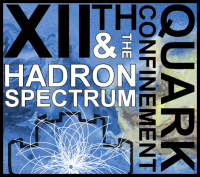Speaker
Description
The low energy (below ~2 GeV) pi-eta channel interaction amplitude becomes an object of interest mainly because of the search for exotic mesons in just beginning to collect data detector GlueX in Jefferson Lab. Finding and interpretation of expected weak signals from these states require a comparison with a very accurate amplitude containing standard (q-bar q) states i.e. a0(980) and a0(1450). The main problem in the determination of such amplitude is a total absence of data about the phases and inelasticities in the elastic and inelastic region.
In addition, it is necessary to take into account the next two coupled higher channels - KK and pi-eta^prime. Presented here amplitude is based on separable potential model (working very well for the scalar-isoscalar pi-pi interactions) with only 9 free parameters. To determine such 3-coupled channel amplitude, the following information has been taken into account: experimental branching ratios and positions of both a0 resonances, theoretical couplings, scattering length from ChPT and value of squared radius of the pi-eta form factor.
Phase shifts, inelasticities and cross sections in all single and crossed channels are presented.
Summary
The low energy (below ~2 GeV) pi-eta channel interaction amplitude becomes an object of interest mainly because of the search for exotic mesons in just beginning to collect data detector GlueX in Jefferson Lab. Finding and interpretation of expected weak signals from these states require a comparison with a very accurate amplitude containing standard (q-bar q) states i.e. a0(980) and a0(1450). The main problem in the determination of such amplitude is a total absence of data about the phases and inelasticities in the elastic and inelastic region.
In addition, it is necessary to take into account the next two coupled higher channels - KK and pi-eta^prime. Presented here amplitude is based on separable potential model (working very well for the scalar-isoscalar pi-pi interactions) with only 9 free parameters. To determine such 3-coupled channel amplitude, the following information has been taken into account: experimental branching ratios and positions of both a0 resonances, theoretical couplings, scattering length from ChPT and value of squared radius of the pi-eta form factor.
Phase shifts, inelasticities and cross sections in all single and crossed channels are presented.
